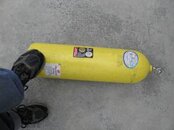minimalistdiver
Registered
I went and looked at a tank I saw on Craigslist today. It was a steel tank made in 1961. I put a light in the tank and there was a little bit of rust and pitting. So it will need to be tumbled and hydro tested.
It is a low pressure smaller tank. I can't remember the size.

I will need to change that old yoke connector to a DIN. The problem is it is an odd smaller diameter hole. It is bigger than .5 inch and smaller than .75 inch. Somewhere in between. My buddy at the LDS said that I need a 300 bar and I will probably need to get an older used one. We didn't measure it but I am hoping one of you will have an idea of what size valve should I be looking for?
Visual, tumbling, and hydro will probably set me back 80 bucks. Plus whatever the valve costs. That is if it passes hydro.
Boy, picking up tanks on Craigslist is not cheep after adding in all the other costs.
I have $125 in a 1995 Aluminum tank that I just did. Saved me a few bucks. But still a chunk of change.
It is a low pressure smaller tank. I can't remember the size.

I will need to change that old yoke connector to a DIN. The problem is it is an odd smaller diameter hole. It is bigger than .5 inch and smaller than .75 inch. Somewhere in between. My buddy at the LDS said that I need a 300 bar and I will probably need to get an older used one. We didn't measure it but I am hoping one of you will have an idea of what size valve should I be looking for?
Visual, tumbling, and hydro will probably set me back 80 bucks. Plus whatever the valve costs. That is if it passes hydro.
Boy, picking up tanks on Craigslist is not cheep after adding in all the other costs.
I have $125 in a 1995 Aluminum tank that I just did. Saved me a few bucks. But still a chunk of change.




